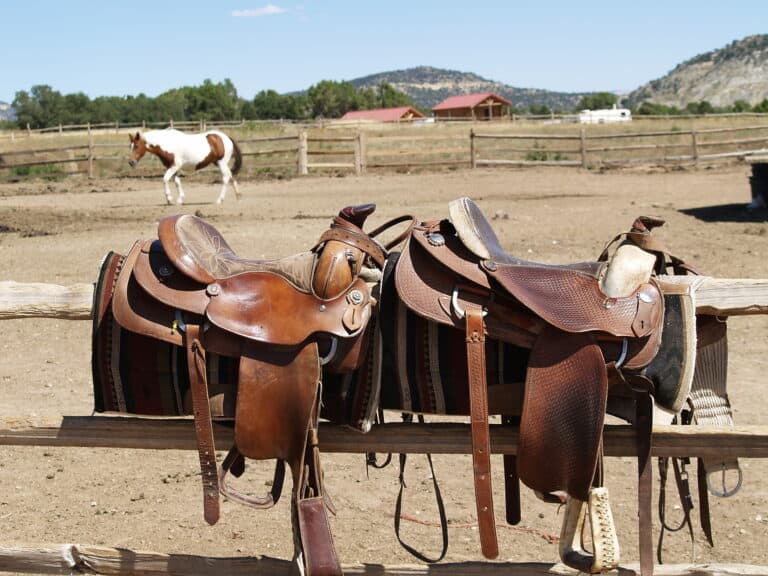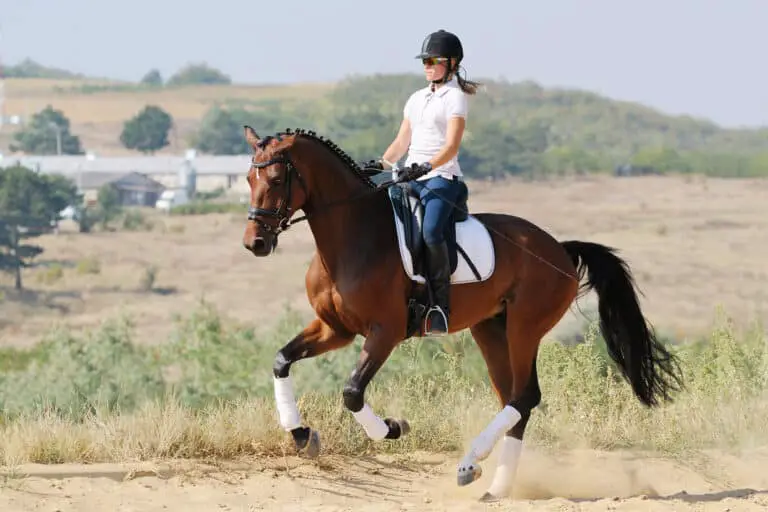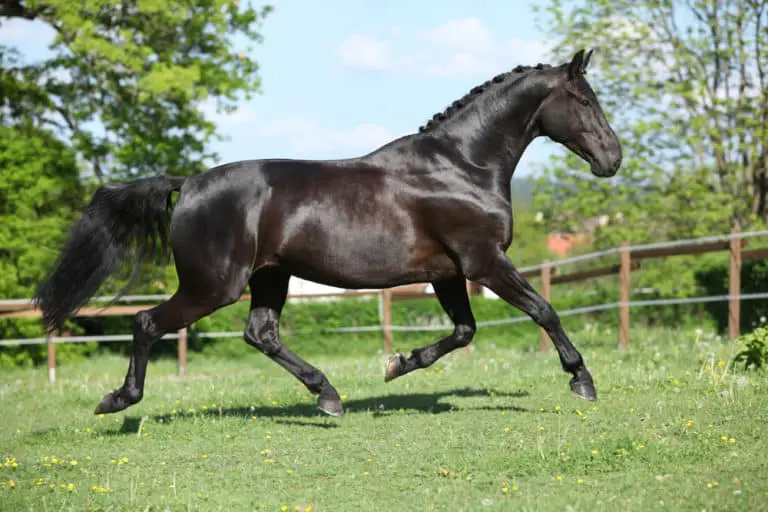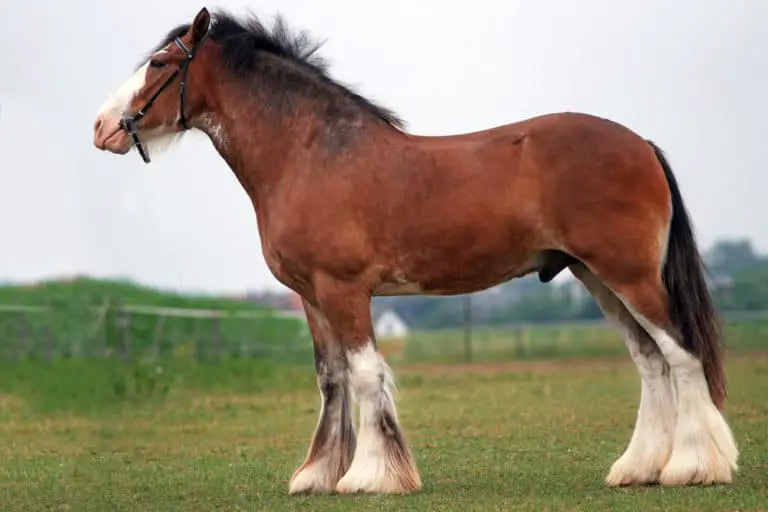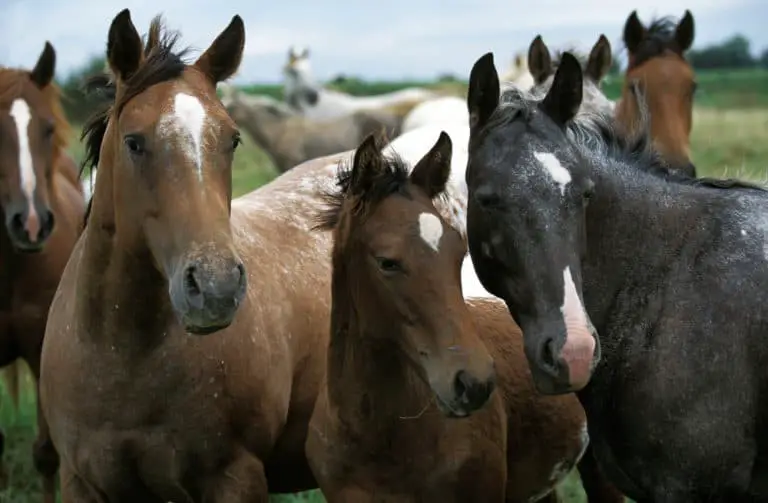Haflinger Horse Breed: Care, Cost & History (2024)

The foothills of the Alps set the stage for Haflinger horse. The golden horses with their flaxen manes and tails were bred to traverse the terrain, creating a sure-footed and intelligent horse that forms a strong bond with the people in its life. Today, the breed is found throughout the world and used for riding and driving.
Breed: Haflinger horse
Adult Weight: 800-1,300 pounds
Adult Height: 13.2-15 hands (54-60 inches)
Origin: Austria and Italy
Use: Riding and driving
Colors: Chestnut with a flaxen mane and tail
Features: Refined head, deep chest, muscled hindquarters
Lifespan: 25-35 years
Character: Friendly and outgoing
Gait: Light, energetic, and sure-footed
Best for: All levels of riders
- Characteristics
- Haflinger Horse Care
- Haflinger Horse History
- Modern Haflingers
- Cost and Ownership
- Buying a Haflinger
- Similar Breeds
Haflinger Horse Characteristics
Haflinger horse characteristics are distinctive, making them easily recognizable among other breeds. The Haflinger horse head is refined, a nod to the Arabian bloodlines of the founding horses, and large, intelligent eyes.
They easily flex at the throatlatch and combined with the long neck, allow them to excel in various disciplines. The deep chest supports their sturdy body and extends through a short back to the muscular hindquarters.
The legs are balanced with the body, straight, and with wide, flat joints. Strong hooves developed in the early years of the mountainous terrain and remain a signature breed characteristic – the hooves are small but hard, allowing them to maneuver in any situation.
Size
The Haflinger horse is a small breed – some are considered Haflinger ponies by commonly accepted measurement standards, but breed organizations worldwide classify them as horses.
Haflinger horse height ranges from 13.2 hands to 15 hands. (1) Breed organizations will not register horses below 13.2 hands although horses taller than 15 hands can be registered if they pass inspection.
Horses with Tyrolean bloodlines are generally smaller, as they were bred for mountain, driving, and military work.
These bloodlines are rarer, and average Haflinger size has increased among the saddle-type horses commonly bred today. Male horses tend to be slightly larger than females, and non-adult horse size is proportionate to their expected mature size.
Weight
The average Haflinger horse weight has a wide range, given the range in height. Horses weigh from 800 to 1,300 pounds, depending on their bone structure and height.
Bone structure is one of the characteristics graded at horse registration inspections, and the Haflinger should have a solid bone structure that is wide and flat. (2) This contributes to their weight and durability.
Males weigh slightly more than females. The Haflinger foal is proportionate to its dam in height and weight and will grow until reaching maturity around four years old. Although they have a reputation as a short stocky horse breed, Haflinger horses carry their weight in an athletic build that shines when they are working.
Colors
Many people mistakenly believe that Haflinger horse colors are palomino. Genetics show that they are chestnuts, with a flaxen mane and tail.
The chestnut color shade can vary, and this is the only color of the breed. Darker chocolate, while still technically chestnut is one of the few rare Haflinger horse colors.
The lighter chestnut color is common, and its abundance is one reason for the palomino misconception.
All horses can have white markings on their face and legs, but never on their body. These accentuate the flaxen mane and tail and are common among breed members of the beautiful Haflinger horse.
Temperament
Temperament is evaluated in breed inspections, and only those with a good Haflinger horse temperament are allowed to reproduce.
Breeders have selected those with the best temperaments for generations, creating a kind horse that enjoys being around people and is a willing worker. Children are not allowed to exhibit stallions, per the United States Equestrian Federation general rules. (3)
Some claim that Haflinger horse behavior is stubborn. This can be true – but the underlying issues also need to be examined. The Haflinger is extremely intelligent, and if they are smarter than their rider, or receive mixed signals, they will challenge the rider or refuse to move.
Haflinger Horse Care
The Haflinger breed is known as easy keepers, and it’s often more important not to overfeed them. Haflingers developed in a tough climate, surviving on very little.
The Haflinger horse lifespan is between 25 and 35 years. Mares continue to carry foals well into their twenties, and some horses continue working into their thirties.
Diet and Nutrition
Water is the most important nutrient for any horse. (4) The average horse also needs to consume 2% of its body weight in feed each day, and Haflinger diet must strictly adhere to this guideline. (4)
Furthermore, diets should be low in starch and sugar because the breed is prone to becoming overweight and metabolic issues.
The Haflinger horse can survive on less feed than other horses. (4) They love grass, and that and hay should be their primary feed sources.
Again, it’s important not to overfeed them, so intake should be monitored. Grain and supplementation may be needed based on the nutritional content of the forage and the horse’s workload. (4)
Health Problems
Haflingers are a hardy breed with relatively few health problems. Overfed horses are prone to laminitis and equine metabolic syndrome. (5) Owners can monitor diet, nutrition, and body condition score to prevent these.
Haflinger horses do have genetic problems though, the breed is prone to Equine Degenerative Myeloencephalopathy. (6) There is no test for the disease, and it can cause ataxia, a lack of muscle control, and death.
Horse owners can help prevent it by making sure their horse is receiving enough Vitamin E. (7) Ocular Squamous Cell Carcinoma or eye cancer is another disease caused by genetic and environmental factors, although testing is available. (8)
Grooming
Regular grooming helps the Haflinger horse maintain its golden sheen and healthy coat. Grooming is a regular part of horse care and should be done daily, or at least several times per week. Hooves should always be cleaned daily. (9)
Haflinger grooming begins with the curry comb, its circular motion and teeth stimulate the coat and help produce the golden sheen. Curry combs are never used on the head or legs. This is followed by a stiff brush and finishing brush. (9)
Extra attention is given to the mane and tail – this keeps them long and flowing, and prevents breaking hair. Some Haflinger horses braid their horses manes to protect them. (10)
Haflinger Horse History
Haflinger horse history is filled with ups and downs, from near extinction to their comeback and worldwide population.
The breed started over 150 years ago in Hafling, which Italy annexed after World War I.
Haflinger horses were used extensively in both world wars, and that’s how they nearly became extinct, but dedicated breeders preserved them.
Origin
The village of Hafling is nestled in the Tyrolean Mountains of the Alps in Italy; although it was in Austria when the breed developed. The breed started in 1874, when Folie, the foundation sire was born.
His excellent conformation, temperament, and good looks made him popular. He also passed these traits on to his offspring, from the Haflinger horse origin.
They are distinguished for their golden chestnut color and flaxen mane and tail. The Haflinger pony was bred to be sure-footed in the mountainous region, for riding and driving.
Folie was sired by an Arabian and the mare was a horse from the Alps region, this combination helped give the breed energy, intelligence, and stamina.
Historic Development
The Haflinger horse breed was officially recognized in 1898 and breeding continued in Austria and Italy. A stud farm was established and records were maintained through a breed organization.
Then, World War I started in 1914 in Europe and breeding stopped. The army used a lot of the Haflinger horses, decreasing the population.
Italy annexed the South Tyrol region where the breed developed, and without the support of the Austro-Hungarian monarchy, the next years were hard on the breed. Italy organized and started breeding the horses, but then World War II started.
Again, horses were extensively used by the military, and the breed was almost extinct by the end of the war. Luckily, breeders re-organized and saved the breed.
Notable Haflinger Horses
There have been many famous Haflinger horses throughout history due to their connection to royalty and their role as recreation and working horses.
It starts with the founding sire, leads us through to Promotea, the first equine clone, and finally to Abendstern, whose Haflinger horse pedigree is recognized globally.
Many other horses are famous in their own right.
Folie
Folie, the foundation Haflinger stallion was born in 1874 on a stud farm in the village of Hafling. His sire was an Arabian, and he was the golden chestnut color that Haflingers are known for. Folie had a star, dorsal stripe, and four white feet. All Haflinger horses trace their bloodlines back to him.
Promotea
Science is pretty cool and the race to clone the first horse was intense. The honor goes to a Haflinger mare named Promotea who was born in Cremonta, Italy on May 28, 2003. The mare was named for Prometheus, who gave fire to the Gods in Greek mythology. She was the clone of the mare that foaled her.
Abendstern
Say the name Abendstern to any Haflinger breeder in the world and they will know exactly who you are talking about. He is honored as an Honorary Stallion by the Tyrolean Haflinger Breeding Association for his contributions. Abendstern was born in 1995, is 15.1 hands, and won numerous world championships.
Myths and Legends
The Haflinger’s history has enough twists and turns for a soap opera, from infighting among breeders to stolen horses. Haflinger horse legends show them surviving these dramatic twists of fate, sometimes through sheer luck. Now, their story has mellowed out and today they are a favorite horse among leisure riders and royalty.
Stolen Horses
World War II had devastating effects, including on the horse population. The Haflinger draft horse types were used by the military. Many of the breed’s survivors were in an area of Italy occupied by the Americans. Thirty stallions were shipped to a remote mountain pasture to preserve the breed. But they were stolen and never seen again.
The Queen’s Horse
Queen Elizabeth of Great Britain visited Austria in 1969 and was presented with two Haflinger horses. They were exported to England, and the Haflinger Society of Great Britain was created. The breed charmed the Queen the same way it does with everyone else, and Haflingers remain part of her vast stables.
The Birth of Pegaso
Pegaso made history when he was born at the research farm in Italy in 2008. His mother, Promotea, was the first cloned horse. Pegaso’s birth was a worldwide sensation, but it’s hard to find any information after that. It’s a mystery if he became a Haflinger gelding, or they kept him a stallion and tried breeding.
Modern Haflinger Horses
The Haflinger horse revolutionized from a stocky breed used to traverse mountain paths to a popular sport horse. The transformation happened because dedicated breeders valued the horse, and understood that different types of Haflinger horses were needed. There are two types of modern Haflinger horses, stocky ones used for work and athletic ones used for leisure.
Breeding
Today, the Haflinger horse is found throughout the world, although most Haflinger breeding still happens in Austria, where the largest population of horses are.
There are seven stallion lines used in Haflinger horses breeding, each with its own bloodlines. The Tyrolean horses reflect the breed’s history and tradition and are shorter, stockier horses.
Modern bloodlines have increased the size and athleticism of the breed. Horse exports have led to Haflinger populations everywhere from Bhutan to Canada and the United States.
Today’s breeders still use Haflingers for work, and they are popular among recreational equestrians in all disciplines from dressage to driving and jumping to endurance.
Population
The Haflinger horse resides in the far corners of the world, but the majority of the population still calls the Alps of Austria and Italy home. There are about 250,000 in the Haflinger horse population. (11)
Some of the horses in this region are still used to carry people and supplies to and from the remote mountain huts that can’t be reached with vehicles.
The Haflinger population in the United States is about 15,000 horses, with dedicated breeders continuously expanding the population. (12) While the breed was once nearly extinct and struggled with inbreeding, today, the population is not endangered, thanks to their transformation into leisure riding horses.
Uses
Today’s Haflinger horse is more than just a workhorse. Haflinger horse uses include the light draft work of their past, as well as all types of leisure saddle pursuits.
Haflingers can be found successfully completing an endurance ride, jumping, or as the mount of a vaulting team. Riders love Haflingers dressage capabilities.
They are popular driving horses in combined driving and pleasure driving. Finally, they are a mainstay in therapeutic riding programs as their height, size, and temperament make them ideal for working with these riders.
The Haflinger horse gait is energetic, yet smooth. They have a ground covering, rhythmic stride, and animated leg action that creates a beautiful image.
Haflinger Horse Prices
Purchasing a horse is just the first in a series of financial commitments that extend throughout the life of the horse, or until it is sold to another owner.
The Haflinger horse price includes their board or stabling each year, feed, veterinary, and hoof care costs. All of these are essential to the care of the animal.
Purchase Price
The purchase price of each breed of horse is dictated by numerous factors that include the availability of horses and their uses. Other factors like age, temperament, and Haflinger horse training further differentiate the price within a breed.
Haflinger horses generally cost between $3,000 and $10,000 to purchase. (13) The price of Haflinger horse increases with those that have a saddle type and for younger horses.
The breed can be considered expensive because there are not as many available as other breeds. There are also some bloodlines within the breed that are more sought after for their temperament and athletic ability, and this increases the purchase price.
Ownership Costs
Horse ownership costs add up quickly, and they aren’t optional expenses. The Haflinger price is the first investment.
After that, a horse owner needs to pay for board, feed, veterinary care, and hoof care each year, many people forget to budget for these.
The Haflinger horse cost of ownership is $1,770 and $12,930 annually.
Board
Board represents your horse’s home; shelter and turnout are imperative. Haflinger horse board cost is between $1,200 and $7,200 per year.
Price is dictated by the type of board, whether you care for the horse at someone else’s property or they take care of it, and the type of shelter and turnout, as well as geography. (14)
Feed
We know that Haflingers don’t require a lot of feed, but they still have to eat. Expect Haflinger horse feed cost to range from $250 to $4,380 a year.
Areas with pasture and an ample hay supply will have lower feed costs. Supplement and grain for nutrition and workload are incorporated into the feed cost. (14)
Veterinary Care
Veterinary care is essential for the health and well-being of all horses. It includes annual vaccinations, deworming, and dental care.
Haflinger horse veterinary cost is between $250 and $300 per year, with increased expenses if the horse is sick or hurt. Veterinary care can be used to prevent overfeeding health issues and check for genetic disorders. (14)
Hoof Care
Horse’s hooves grow continuously, the same way human fingernails do. As such, they need to be trimmed every six to eight weeks by a farrier.
Haflinger horse hoof care cost is $120 to $1,000 annually. Horses with a heavy workload may require shoes and would be on the more expensive end of the price range. (14)
Buying a Haflinger Horse
The decision to buy a horse shouldn’t be taken lightly. Do your homework, learn about the breed, and decide what your goals are.
The Haflinger breed is intelligent, and each horse has a distinct personality. It’s important to meet the horse before you buy it to determine if your personalities will work well together.
Is the Haflinger Horse Right for You?
The Haflinger horse is right for you if you want an energetic horse that is smart, athletic, and a hard worker. Owning a Haflinger horse is a time and financial commitment, but also a commitment to ensuring the horse’s happiness. Horses want to have a job and your horse will need regular exercise and enrichment through riding or driving.
The breed is suitable for all levels of equestrians as long as the horse and human are well matched. Trained horses can be good for beginners and families. Riding a Haflinger horse is a fun experience, with their ground covering stride and sure-footed gaits instilling confidence.
How to Buy a Haflinger Horse?
The purchase process begins with a Haflinger breeder. These people have the best understanding of the breed and current population and can provide valuable insights about horse families and those available for sale.
Create a list of ideal traits when buying a Haflinger horse, include your budget on this list. Then, identify horses for sale and visit them.
Try several horses before making your final decision to help ensure you pick the right one. Avoid horses with a bad temperament, red flags are anything from being grumpy to challenging you on a test ride by refusing to move or being hard to stop.
Similar Breeds to Haflinger
There are Haflinger breed alternatives, including the Gypsy Horse, Norwegian Fjord, and Virginia Highlander. The Fjord also developed in a mountainous region and has a distinct color.
Gypsy Horses are another breed developed for light draft work, similar to Fjords and Haflingers. The Virginia Highlander has a similar temperament and energetic gaits like the Haflinger.
Gypsy Horse
The Gypsy horse breed developed in Great Britain and Ireland to pull the vans of traveling gypsies. They are a cob size horses, meaning a smaller height, but with a sturdy build that can pull the heavy wagons. Colorful coat patterns are usually piebald or skewbald. They are known for kind personalities and being gentle with children.
Norwegian Fjord
The Norwegian Fjord horse is another small, stocky breed that developed in a mountainous region. These sure-footed horses are known for their dun color and dorsal stripe. Fjords were bred for farm work and are still used for light draft work in Norway and other parts of the world, as well as being riding horses.
Virginia Highlander
The Virginia Highlander is a new breed of horse in the United States, the registry formed in the 1990s. Horses are between 13 and 14 hands and have a kind temperament and spirited action. It’s a rare breed, less than 150 horses, that traces back to one stallion, Pogo, who was born in 1960.
FAQ
What is a Haflinger horse?
A Haflinger horse is a small, hardy breed of horse that developed near the Alps in Austria and Northern Italy.
What does a Haflinger horse look like?
Haflinger horses are a shorter, stocky breed that is golden in color with a flaxen mane and tail.
How did the Haflinger horse get its name?
The Haflinger horse is named for the Hafling village in the Alps where the foundation stallion was born.
Can you ride a Haflinger horse?
Yes, Haflinger horses are fun to ride and used in many disciplines.
Are Haflinger horses good for beginners?
Haflinger horses are kind, intelligent, and calm. They are good horses for beginners and popular family horses.
How tall is a Haflinger horse?
A Haflinger horse is between 13.2 and 15 hands (54-60 inches) tall.
How much does a Haflinger horse weigh?
Haflinger horses weigh between 800 and 1,300 pounds.
How big is a Haflinger horse?
Haflinger horses are smaller and stockier. Although smaller than other breeds their muscular body type means they are strong.
How much does a Haflinger horse cost?
It costs between $3,000 and $10,000 to buy a Haflinger horse.
How much does a Haflinger horse ownership cost?
Haflinger horse ownership costs between $1,770 and $12,930 each year.
How long do Haflinger horses live?
The average lifespan of a Haflinger horse is between 25 to 35 years, with some still working well into their 30s.
How fast can a Haflinger horse run?
A Haflinger can run 25 to 30 miles per hour.
How much can a Haflinger horse pull?
A Haflinger horse can pull anywhere from 1,200 to 1,950 pounds.
How much can a Haflinger horse carry?
The Haflinger horse can carry 160 to 260 pounds, depending on its size.
At what age is a Haflinger horse full grown?
Haflinger horses are full-grown at four years old.
What are Haflinger horses used for?
Haflinger horses are used for riding and driving, the militaries in Austria and Germany still use them in the mountainous terrain.
References
- American Haflinger Alliance. 2022. Breed Standard. Link
- American Haflinger Registry. 2022. Inspection & Classification. Link
- United States Equestrian Federation. 2022. Licensed Competitions. Link
- Nova Scotia Haflinger Club. 2022. Feeding the Haflinger. Link
- Nova Scotia Haflinger Club. 2022. Feed Related Health Issues. Link
- Fédération Équestre Internationale. 2021. Breed Profile: The Haflinger. Link
- UC Davis Veterinary Medicine. 2020. Equine Neuroaxonal Dystrophy (eNAD) and Equine Degenerative Myeloencephalopathy (EDM). Link
- American Haflinger Alliance. 2022. Health. Link
- University of Wyoming Cooperative Extension Service. 2002. The 4-H Horse Project: An Introduction. Link
- United States Equestrian Federation. 2022. Pro Tip: Mane and Tail Care. Link
- Haflinger Tirol. 2022. History of the Haflinger Breed. Link
- American Haflinger Registry. 2022. The Registry. Link
- American Haflinger Registry. 2022. Marketplace. Link
- Arabian Horse Association. 2022. What is the Cost of Providing for Them? Link

